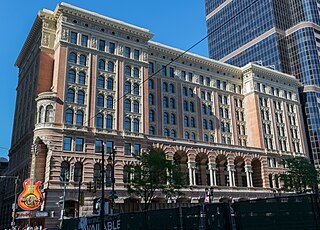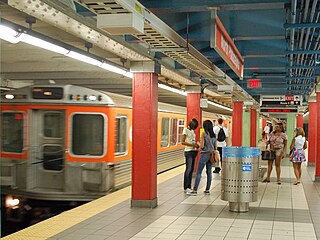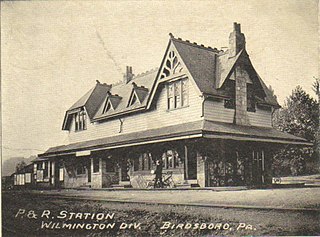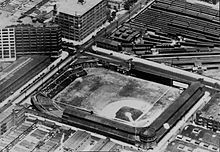
The Southeastern Pennsylvania Transportation Authority (SEPTA) is a regional public transportation authority that operates bus, rapid transit, commuter rail, light rail, and electric trolleybus services for nearly four million people in five counties in and around Philadelphia, Pennsylvania. It also manages projects that maintain, replace and expand its infrastructure, facilities and vehicles.

The Broad Street Line (BSL), also known as the Broad Street subway (BSS), Orange Line, or Broad Line, is a subway line owned by the city of Philadelphia and operated by the Southeastern Pennsylvania Transportation Authority (SEPTA). The line runs primarily north-south from the Fern Rock Transportation Center in North Philadelphia through Center City Philadelphia to NRG station at Pattison Avenue in South Philadelphia; the latter station provides access to the stadiums and arenas for the city's major professional sports teams at the South Philadelphia Sports Complex, about a quarter mile away. It is named for Broad Street, under which the line runs for almost its entire length.

The SEPTA Regional Rail system is a commuter rail network owned by SEPTA and serving the Philadelphia metropolitan area. The system has 13 branches and more than 150 active stations in Philadelphia, Pennsylvania, its suburbs and satellite towns and cities. It is the sixth-busiest commuter railroad in the United States, and the busiest outside of the New York, Chicago, and Boston metropolitan areas. In 2016, the Regional Rail system had an average of 132,000 daily riders and 118,800 daily riders as of 2019.

8th Street station is a subway station complex in Philadelphia, Pennsylvania, at the intersection of 8th Street and Market Street in Center City. It is served by SEPTA's Market–Frankford and Broad–Ridge Spur lines, as well as the PATCO Speedline. The entire complex is owned by SEPTA, while the PATCO areas are leased by the Delaware River Port Authority, which operates that line. 8th Street is the only station in Philadelphia where these three subway lines interchange.

Suburban Station is an art deco office building and underground commuter rail station in Penn Center in Philadelphia. Its official SEPTA address is 16th Street and JFK Boulevard. The station is owned and operated by SEPTA and is one of the three core Center City stations on the SEPTA Regional Rail and one of the busiest stations in the Regional Rail System.

Transportation in Philadelphia involves the various modes of transport within the city and its required infrastructure. In addition to facilitating intracity travel, Philadelphia's transportation system connects Philadelphia to towns of its metropolitan area and surrounding areas within the Northeast megalopolis.
Schuylkill River Passenger Rail is a proposed passenger train service along the Schuylkill River between Philadelphia and Reading, Pennsylvania, with intermediate stops in Norristown, King of Prussia, Phoenixville, and Pottstown.

Paoli station is a passenger rail station located in the western suburbs of Philadelphia at 13 Lancaster Avenue, Paoli, Pennsylvania. It is served by Amtrak's Keystone Service and Pennsylvanian trains, and most SEPTA Paoli/Thorndale Line trains.

The Reading Terminal is a complex of buildings that includes the former Reading Company main station located in the Market East section of Center City in Philadelphia, Pennsylvania, United States. It comprises the Reading Terminal Headhouse, Trainshed, and Market.

The Fern Rock Transportation Center is a SEPTA rail and bus station located at 10th Street and Nedro Avenue in the Fern Rock neighborhood of Philadelphia, Pennsylvania. Fern Rock serves as the northern terminus and yard for SEPTA's Broad Street Line, as well as a stop for SEPTA Regional Rail's Lansdale/Doylestown Line, Warminster Line, and West Trenton Line.

Wayne Junction station is a SEPTA Regional Rail junction station located at 4481 Wayne Avenue, extending along Windrim Avenue to Germantown Avenue. The station is located in the Nicetown neighborhood of Philadelphia. Wayne Junction serves as a multi-modal transfer point between six of SEPTA's regional rail lines as well as three major transit routes – the Route 75 Trackless Trolley and the Route 23 and 53 bus lines. The station served more than 321,000 riders annually in 2018.

Ridley Park station is a station along the Northeast Corridor. Amtrak does not stop here; only SEPTA's Wilmington/Newark Line trains serve this station. It is located at Hinckley & Morton Avenues in Ridley Park, Pennsylvania, and contains a one-story station house similar to that of Media Regional Rail station built into the embankment next to a platform, as well as a passenger drop-off area at Hinckley Avenue and Lincoln Street. Another platform also exists on the opposite side of the tracks on Ridley & Morton Avenues. Access between the two platforms is available from the nearby Ward Street Bridge just west of the station.

Route 11, also known as the Woodland Avenue Line, is a trolley line operated by the Southeastern Pennsylvania Transportation Authority (SEPTA) that connects the 13th Street station in downtown Philadelphia, Pennsylvania, to Darby Transportation Center in Darby, Pennsylvania. It is one of five lines that are part of the subway–surface trolley system. Sitting at an average of 13,580 riders per weekday in 2019, it is the most used subway-surface trolley route, even though it lacks overnight service.

Bethayres station is a SEPTA Regional Rail station in Bethayres, Pennsylvania. It is located at Station Avenue and Old Welsh Road and serves the West Trenton Line to Ewing, New Jersey. Bethayres station was originally built in 1876 by the Reading Railroad. The station has off-street parking and a ticket office. There is also a handicapped-accessible platform. In FY 2013, Bethyares station had a weekday average of 578 boardings and 553 alightings. Bethayres is the last boarding stop for AM peak service express trains to Philadelphia and the first discharge stop for PM peak service express trains from Philadelphia.

North Philadelphia station is an intercity rail and regional rail station on the Northeast Corridor, located on North Broad Street in the North Philadelphia neighborhood of Philadelphia, Pennsylvania, United States. SEPTA Regional Rail's Trenton Line and Chestnut Hill West Line account for most of the station's service. Three Amtrak trains, two southbound and one northbound, stop on weekdays only.
The Philadelphia, Newtown and New York Railroad was a railroad in southeastern Pennsylvania that is now a part of the SEPTA commuter rail system as the Fox Chase Branch. Despite the name, it only ever extended between Philadelphia and Newtown, Pennsylvania.

North Philadelphia station is a rapid transit station on SEPTA's Broad Street Line. It serves both local trains and Broad-Ridge Spur trains. It is located in Philadelphia under North Broad Street with headhouses at Glenwood Avenue and Lehigh Avenue.

The Manayunk/Norristown Line is a commuter rail service in Southeastern Pennsylvania between Center City Philadelphia and Norristown, and one of the 13 lines in SEPTA's Regional Rail network. It has the second highest operating ratio (19.9%) on the SEPTA Regional Rail network.

The Reading Company used two passenger railway stations in or near Birdsboro, Pennsylvania. The Philadelphia and Reading Railroad built a station on its Main Line in Exeter Township, on the opposite side of the Schuylkill River from Birdsboro. The Wilmington and Northern Railroad established a freight line to Birdsboro in 1870, but it was not until after its merger with the Reading Company that its passenger station was built in the borough.


























